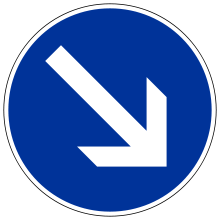- Mandatory sign
-
 German mandatory road sign indicating "pass on right".
German mandatory road sign indicating "pass on right".
Mandatory signs are road signs which are used to set the obligations of all traffic which use a specific area of road. Unlike prohibitory or restrictive signs, mandatory signs tell traffic what it must do, rather than must not do. Most mandatory road signs are circular, may use white symbols on a blue background with white border or black symbols on a white blackground with a red border, although the latter is also associated with prohibitory signs.[1]
Contents
Design
Mandatory signs are a subset of the regulatory sign group as defined by the United Nations Economic and Social Council in the Vienna Convention on Road Signs and Signals of 1968, and are often seen not just on their own, but used in conjunction with other signs, traffic lights and bollards as a form of visual shorthand within these objects.[1] In Vienna signatories, the mandatory sign is either a light blue circle with a white border or a white circle with a red border. The sign must be at least 60 cm (1.96 ft) across on rural roads, or 40 cm (1.31 ft) in built-up areas, although mandatory signs incorporated in traffic lights, bollards or larger road signs can be as little as 30 cm (0.98 ft) in diameter.
The mandatory sign group is not used in the United States and Canada,[2][3] who are not signatories to the Vienna Convention; both countries consider them kinds of regulatory signs. Some Canadian provinces differentiate mandatory signs from prohibitive ones by enclosing the symbols in a green rather than red border, although this can indicate either a mandatory or a warning sign, while in the U.S., the only difference between a prohibitory sign and a mandatory one is that a mandatory sign includes the word "only" at the bottom of the plate instead of crossing out the pictogram.[2]
Uses
Segregation of roads
Mandatory road signs can be used to allocate certain areas to specific vehicles - the Vienna Convention explicitly mentions footpaths, cyclepaths and bridleways, but tramways, bus lanes, taxi lanes, HOV lanes and snow mobile tracks can also be designated with mandatory signs. When a specific area of roadway is designated with a mandatory sign specifying a vehicle type, all traffic of this type must use this area if possible. These signs can be combined by putting one pictogram above the other. If the pictograms are side-by-side however, with the sign divided by a white vertical line, each type of vehicle must stay within the lane indicated by the sign. A red line through a mandatory sign indicates not that a vehicle of a specific type is prohibited from entering the designated area, but that the area is now deregulated and any vehicle may use it.[1]
Instruction
Mandatory signs can also be used to issue instructions to all vehicles - common examples include "pass on this side" signs seen at roadworks, and "compulsory roundabout" signs seen at mini-roundabouts. Other signs of the type include "attach snow chains" and "remove snow chains" seen at the entry and exit points of mountainous areas, and "compulsory direction for vehicles carrying dangerous loads", used to divert vehicles carrying explosives or poisonous chemicals away from areas with open flames such as oil refineries. Minimum speed limits can also be defined using mandatory road signs, although such signs are rare in most countries; the U.S., which does not use mandatory signs, instead places minimum speed limits on the same type of panel as maximum speed limits.[1][2]
References
- ^ a b c d Vienna Convention on Road Signs and Signals. United Nations Economic and Social Council. 6 June 1978. p. 44–46. http://www.unece.org/trans/conventn/signalse.pdf. Retrieved 2007-09-14.
- ^ a b c "Regulatory Signs". Manual on Uniform Traffic Control Devices. Federal Highway Administration. http://mutcd.fhwa.dot.gov/HTM/2003r1/part2/part2b1.htm. Retrieved 2007-09-14.
- ^ "Traffic Signs And Lights". Ontario Ministry of Transportation. Archived from the original on 2007-09-11. http://web.archive.org/web/20070911072430/http://www.mto.gov.on.ca/english/dandv/driver/handbook/section3b3.htm. Retrieved 2007-09-14.
Traffic signs Signs Warning sign · Regulatory sign · Priority to the right · Yield sign · Stop sign · Prohibitory traffic sign · One-way traffic · Speed limit (by country) · Advisory speed limit · Mandatory sign · Special regulation sign · Information sign · Direction, position, or indication sign · Variable-message sign · Bilingual sign · Comparison of European traffic signs · Driver location signs · CrossbuckBy country Lights Typefaces Allerta · Austria (typeface) · Clearview · DIN 1451 · Drogowskaz · FHWA Standard Alphabets for Traffic Control Devices · Frutiger · Caractères · NPS Rawlinson Roadway · Trafikkalfabetet · Transport · TratexConventions Geneva Convention on Road Traffic · Vienna Convention on Road Traffic · Vienna Convention on Road Signs and Signals · Manual on Uniform Traffic Control Devices (USA) · Traffic Signs Regulations and General Directions (UK)Categories:- Traffic signs
Wikimedia Foundation. 2010.



